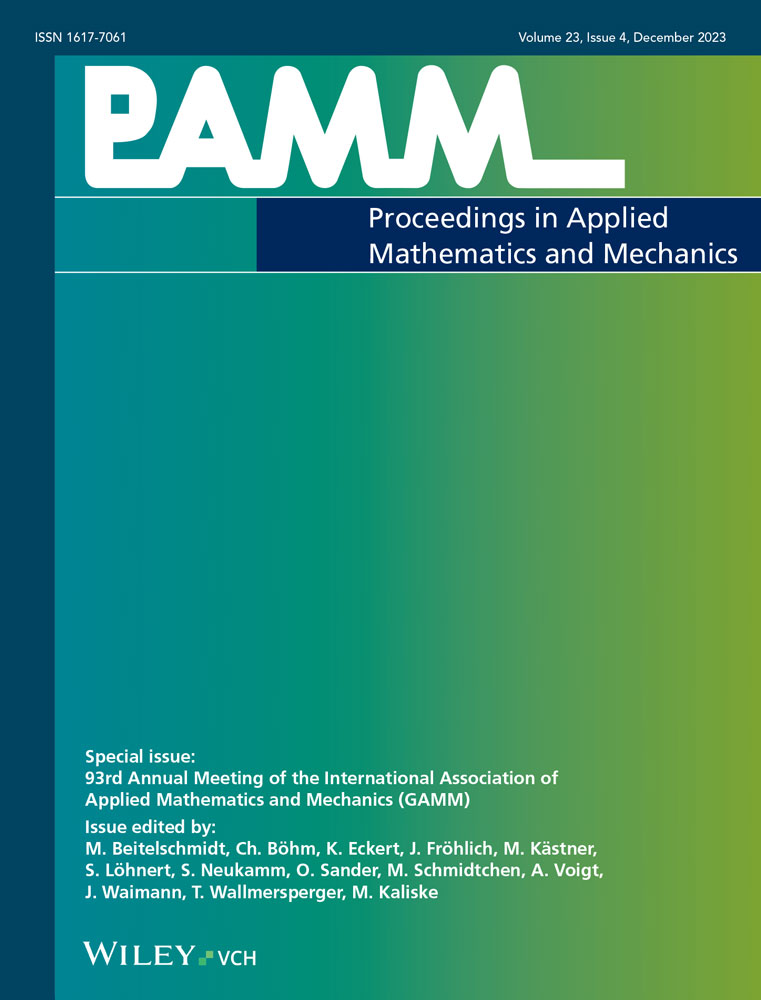Variational models for pattern formation in biomembranes—A Γ-convergence result
Corresponding Author
Anastasija Pešić
Humboldt-Universitat zu Berlin, Berlin, Germany
Correspondence
Anastasija Pešić, Humboldt-Universitat zu Berlin, Unter den Linden 6, 10099 Berlin, Germany.
Email: [email protected]
Search for more papers by this authorCorresponding Author
Anastasija Pešić
Humboldt-Universitat zu Berlin, Berlin, Germany
Correspondence
Anastasija Pešić, Humboldt-Universitat zu Berlin, Unter den Linden 6, 10099 Berlin, Germany.
Email: [email protected]
Search for more papers by this authorAbstract
Biological membranes are thin structures that are composed of various components. The different components often form microdomains, called lipid rafts, that are arranged in complex patterns. To explain this pattern formation, variational models based on Cahn–Hilliard-type energies have been introduced that couple the local composition of the membrane to its local curvature, which renders the resulting functionals nonlocal. In this note, we review and extend recent qualitative results on related variational models. This includes a technique to deal with Neumann-boundary conditions in the construction of a recovery sequence.
REFERENCES
- 1Braides, A. (2002). Gamma-convergence for beginners (Vol. 22). Clarendon Press.
10.1093/acprof:oso/9780198507840.001.0001 Google Scholar
- 2Braides, A., Conti, S., & Garroni, A. (2017). Density of polyhedral partitions. Calculus of Variations and Partial Differential Equations, 56(28), 28.
10.1007/s00526-017-1108-x Google Scholar
- 3Brazke, D., Knüpfer, H., & Marciniak–Czochra, A. (2023). Γ–limit for a sharp interface model related to pattern formation on biomembranes. Calculus of Variations and Partial Differential Equations, 62(3), 94.
- 4Burger, M., Esposito, T., & Zeppieri, C. I. (2015). Second-order edge-penalization in the Ambrosio-Tortorelli functional. Multiscale Modeling and Simulation, 13(4), 1354–1389.
- 5Canham, P. B. (1970). The minimum energy of bending as a possible explanation of the biconcave shape of the human red blood cell. Journal of Theoretical Biology, 26(1), 61–81.
- 6Carr, J., Gurtin, M. E., & Slemrod, M. (1984). Structured phase transitions on a finite interval. Archive for Rational Mechanics and Analysis, 86, 317–351.
- 7Chermisi, M., Dal Maso, G., Fonseca, I., & Leoni, G. (2011). Singular perturbation models in phase transitions for second order materials. Indiana University Mathematics Journal, 60(2), 367–410.
- 8Cicalese, M., Spadaro, E., & Zeppieri, C. (2011). Asymptotic analysis of a second-order singular perturbation model for phase transitions. Calculus of Variations and Partial Differential Equations, 41(1–2), 127–150.
- 9Elliott, C. M., Hatcher, L., & Herbert, P. J. (2019). Small deformations of spherical biomembranes. In The role of metrics in the theory of partial differential equations. Advanced studies in pure Mathematics (Vol. 85). Mathematical Society of Japan.
- 10Fonseca, I., Hayrapetyan, G., Leoni, G., & Zwicknagl, B. (2016). Domain formation in membranes near the onset of instability. Journal of Nonlinear Science, 26, 1191–1225.
- 11Fonseca, I., & Mantegazza, C. (2000). Second order singular perturbation models for phase transitions. SIAM Journal on Mathematical Analysis, 31, 1121–1143.
- 12Fonseca, I., & Müller, S. (1992). Quasiconvex integrands and lower semicontinuity in L1. SIAM Journal on Mathematical Analysis, 23, 1081–1098.
- 13Goñi, F. M. (2019). “Rafts”: A nickname for putative transient nanodomains. Chemistry and Physics of Lipids, 218, 34–39.
- 14Ginster, J., Hayrapetyan, G., Pešić, A., & Zwicknagl, B. (2023). A sharp interface limit of a nonlocal variational model for pattern formation in biomembranes. cvgmt preprint.http://cvgmt.sns.it/paper/6040/
- 15Ginster, J., Pešić, A., & Zwicknagl, B. (2023). In preparation.
- 16Helfrich, W. (1973). Elastic properties of lipid bilayers: Theory and possible experiments. Zeitschrift für Naturforschung C, 28(11–12), 693–703.
- 17Hilhorst, D., Peletier, L., & Schätzle, R. (2002). Γ-limit for the extended Fisher-Kolmogorov equation. Proceedings of the Royal Society of Edinburgh Section A: Mathematics, 132(1), 141–162.
10.1017/S0308210500001566 Google Scholar
- 18Komura, S., Shimokawa, N., & Andelman, D. (2006). Tension-induced morphological transition in mixed lipid bilayers. Langmuir, 22(16), 6771–6774.
- 19Modica, L., & Mortola, S. (1977). Un esempio di Γ-convergenza. Bollettino dell'Unione Matematica Italiana B, 14(1), 285–299.
- 20Modica, L. (1987). The gradient theory of phase transitions and the minimal interface criterion. Archive for Rational Mechanics and Analysis, 98(2), 123–142.
- 21Munro, S. (2003). Lipid rafts: Elusive or illusive? Cell, 115, 377–388.
- 22Pešić, A. (2021). Membrane models: Variational analysis and large deviations principle in subcritical dimensions [Master's thesis, Humboldt-Universität zu Berlin].
- 23Sapoń, K., Mańka, R., Janas, T., & Janas, T. (2023). The role of lipid rafts in vesicle formation. Journal of Cell Science, 136(9), jcs260887.
- 24Simons, K., & Ikonen, E. (1997). Functional rafts in cell membranes. Nature, 387(6633), 569–572.
- 25Sternberg, P. (1988). The effect of a singular perturbation on nonconvex variational problems. Archive for Rational Mechanics and Analysis, 101(3), 209–260.
- 26Rajendran, L., & Simons, K. (2005). Lipid rafts and membrane dynamics. Journal of Cell Science, 118(6), 1099–1102.
- 27Rozovsky, S., Kaizuka, Y., & Groves, J. T. (2005). Formation and spatio-temporal evolution of periodic structures in lipid bilayers. Journal of the American Chemical Society, 127(1), 36–37.




